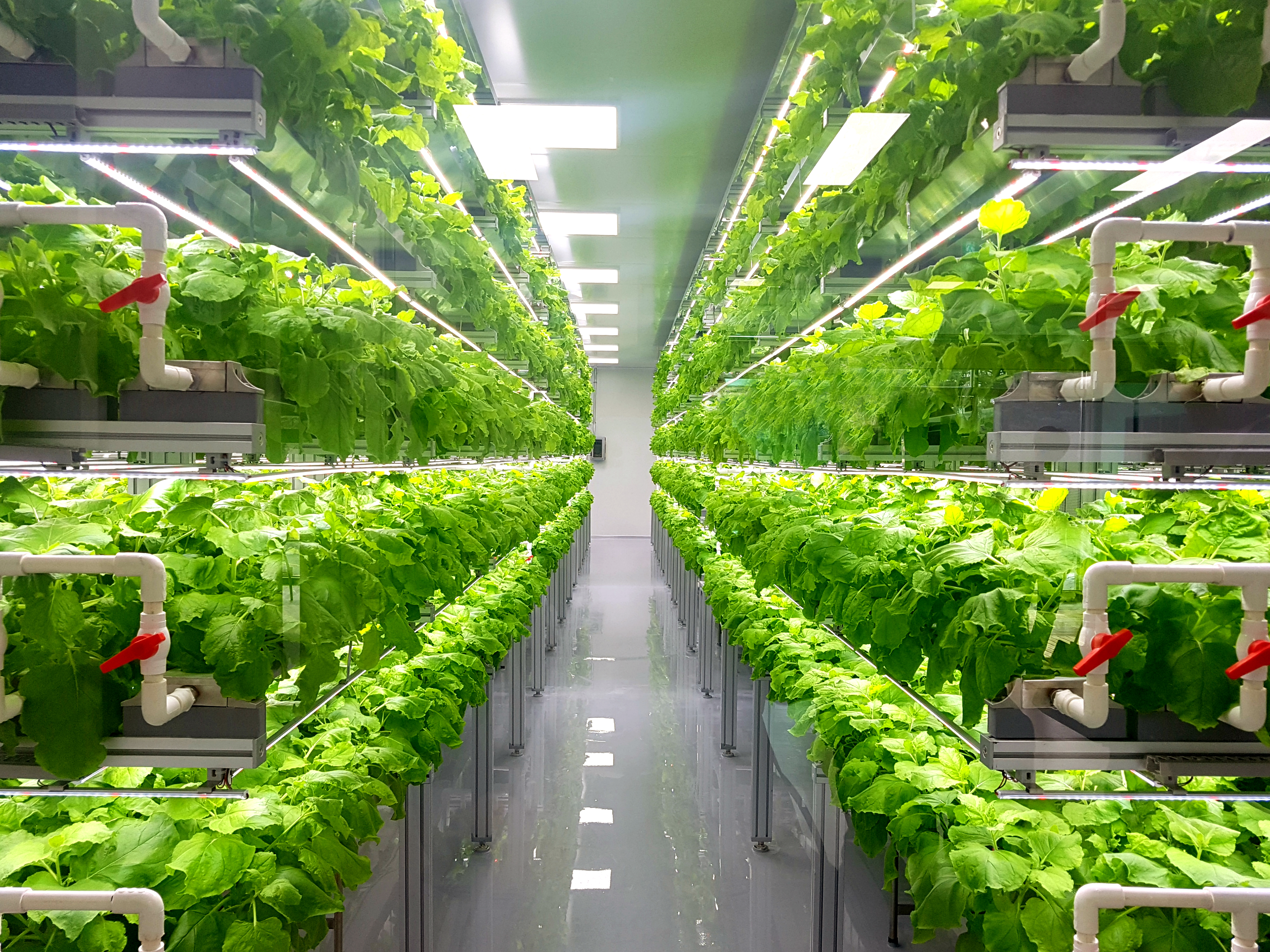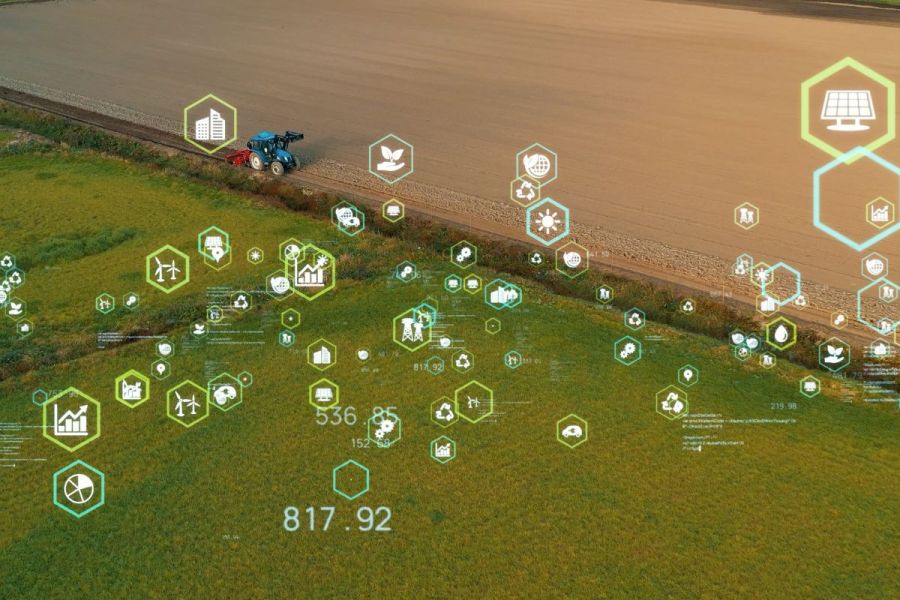Agri-tech innovation centres are helping pave the way to a more sustainable era of precision farming, be it through the medium of miniscule nanobubbles or to the heights of vertical growing. CPM learns more.
“Nanobubbles are going to be of international significance, both environmentally and economically as we head into the future.”
By Melanie Jenkins
There’s a character in Disney’s Finding Nemo, aptly called ‘Bubbles’, who is obsessed and hyperactively excited by its namesake being expelled from a chest in a fish tank. It might seem a far stretch to link agriculture to this but an emerging disruptive technology, known as bulk nanobubbles – BNB for short – is opening up an entirely new world of exciting opportunities for agriculture and all through the medium of bubbles.

Nanobubble technology could help reduce dependency on inorganic fertiliser, by optimising precision application and enhancing plant uptake.
Nanobubbles – also known as ultra-fine bubbles (UFBs) – are microscopic, stable and long-lasting bubbles that have the potential to revolutionise agricultural practices such as germination, irrigation, fertigation, spraying, disease management and more. “Nanobubbles are going to be of international significance, both environmentally and economically as we head into the future,” says Les Hurdiss of Agri-EPI Centre.
Funded by Innovate UK, the Ultra-fine Bubble project seeks to explore the potential for agricultural applications of nanobubbles and their integration with other technologies. Initially focussing on irrigation, led by MagGrow UK in association with Agri-EPI Centre and the Centre for Crop Health and Protection (CHAP), the team are working with Cranfield University. The goal was to specifically compare the growth of plants treated with oxygen-containing nanobubble water with that of plants given untreated water, measuring root development, nutrient absorption, growth and crop yield.
Using Agri-EPI and CHAP’s Phenotyping and Soil Health facility at Cranfield University, the project partners assessed and explored the application of this innovative technology and its potential role in transforming UK crop production, explains Richard Glass of CHAP.
For Agri-EPI’s Dr Trish Toop it’s a really exciting opportunity to further explore capabilities in plant phenotyping – the ability to measure the structure and function of plants. “Nanobubbles offer great potential within agriculture and our research will allow us to greatly progress knowledge and understanding of useful treatments.”
But what makes this research into nanobubbles so special? According to Dr Anthony Furness of MagGrow, nanobubbles are based on existing established microbubble technology, which has been used in water, sterilisation, medical and mineral industries, but takes the science even further.
Nanobubbles offer a smaller, stabler and longer lasting solution, says Anthony. “These bubbles are so small they’re invisible to the naked eye, being between 10nm and 1000nm in diameter.”
This means they’re hundreds of times smaller than the width of a human hair and are about the size of a virus. “Based on classical physics, bulk nanobubbles should dissolve in micro-seconds, but they don’t,” he explains.
The theory is that they behave in this unexpected way because they’re negatively electrically charged, adds Anthony. “And when present in large numbers in water-based liquids, they don’t rise to the surface and burst but remain stable and buoyant for long periods of time.” This can typically be days or even weeks and when refrigerated have been found present up to a year later.
One of the key characteristics of nanobubbles is their surprisingly stable gas-liquid interface, he says. “The surface area to volume characteristics of large populations of these bubbles means there’s a significant gas carrying capability. And they also have both internal and surface adhesion properties, meaning they can carry substances both inside the bubbles themselves and attached to their surface.”
Beyond this, nanobubbles can influence bodies of liquid they’re suspended in, particularly aqueous solutions. But their stability is influenced by things such as pH and salt content, adds Anthony. “They are more stable in alkaline conditions.”
Nanobubbles also have colloidal properties relating to how they aggregate with a medium, if they do so at all. Due to their size, there’s huge scope to further explore their penetrative abilities.
But how can this technology be used in agriculture? “There’s a real environmental significance relating to nanobubble for use in precision farming and for meeting global challenges, alongside commercial objectivity,” says Anthony.
As nanobubbles can be used to contain gases, there’s potential for them to be used to help with environmental issues, including removal of harmful pesticide residues, he explains. “Oxidised nanobubbles could well be used as a platform for tackling pollution problems such as pesticide residues and for water treatment.”
And it’s not just pesticides they could remove, their use could extend to both organic and inorganic compounds, including microplastics.
“Levels of nitrogen and phosphates are already at dangerous levels in some soils and watercourses, and we have to reduce the amount of these substances to limit pollution,” says Anthony.
Using nanobubble technology could prevent further pollution using flotation techniques, he adds. “As well as their potential for water treatment, they could help reduce our dependency on inorganic fertiliser, by optimising precision application and enhancing plant uptake, and could also help to prevent the ammonia and nitrous oxide greenhouse gas emissions associated with fertiliser application,” he adds.
They could even be used as an agent to deliver nutrients and oxygen to plant root systems to enable better plant growth through root oxygenation and fertigation. “Oxygen generated nanobubbles act as oxidants and can accelerate germination,” he says. “But hydrogen induced into nanobubbles acts as an antioxidant and can inhibit germination. This is an area of active research.”
Further avenues of agricultural-related research into nanobubbles include foliar feeding, gene switching, abiotic elicitation, soil remediation, seed germination and pathogen treatment.
“The versatility of nanobubble technology, and recent advances in research, suggests that there’s huge potential for their use in advancing spraying and irrigation processes,” says Anthony. “Not only will this help serve to address global food security challenges and the question of how farming can be more sustainable, productive and profitable, but also offers huge potential for new enterprises and job creation across the UK.”
But from some of the smallest forms of agricultural science to the very tall, agri-tech is also helping to explore and further the possibilities of vertical growing. Although this technology has been around for a few years, it’s constantly advancing and expanding to new realms and presents the possibility to cut emissions and grow some food produce more sustainably.
There are various research facilities looking at vertical farming across the UK, and the Vertical Farming Development Centre at Stockbridge Technology Centre (STC) was set up as a commercial demonstrator. In collaboration with CHAP, this 224m² facility, split across two identical chambers, allows testing of vertical farming technologies, processes or crop varieties, as well as large scale trials before heading to a commercial market, explains Lucy Plowman of CHAP.
One of the on-going projects being conducted at STC is looking at using hydrogel as a growing medium, something which offers an important step towards more sustainable production, says Lucy. “Typically, rockwool, coconut coir or peat are used in vertical growing but these have a notable carbon impact, so the project is looking at hydrogel as a sustainable alternative.”
Funded by Innovate UK, the Gelponics project is a collaboration between AEH Innovative Hydrogel and CHAP. Aimed at decarbonising the hydroponics element of vertical farming, this new substrate innovation could potentially transform the sustainable credentials of vertical farming, says Dr Beenish Siddique of AEH Innovative Hydrogel.
“Our focus is to phase out peat as a growing medium in agriculture, given the impending ban on its use,” she says. “Although a challenge, this is a great opportunity for businesses to improve their position on sustainability. The global substrate market was worth over $5bn in 2019, so it’s not just about sustainability but also a financial opportunity.
“We’re doing this through Gelponics – a range of non-synthetic hydrogel formulations that can significantly reduce the carbon footprint of systems such as vertical farming or greenhouse production.
“As part of development work we’re doing, we’ve conducted germination trials using the substrate. These have demonstrated more than 90% success rate for crops such as lettuce, basil and spinach, which is very promising,” adds Beenish.
“The unique selling points of the Gelponics system relate to the hydrogel itself, which has a significant water-holding capacity, is both recyclable and reusable, and can incorporate graphene technology that optimises nutrient delivery to the plant roots.”
As well as being recyclable and compostable, the hydrogel product can be reused locally as a soil amendment to help sequester carbon. It also has export potential in dry form to countries with water scarcity, adds Lucy.
Gelponics can be used in a wide range of agricultural settings and the product comes in three forms; plugs, sheets and granules, says Beenish. “The granules are mostly for use in traditional agriculture as they have natural N, P and K in them, so not only can they reduce water usage, but also help growers use fewer fertiliser inputs.”
The next phases of the Gelponics project will see CHAP and STC conduct full, semi-commercial trials of the sheet product within its own vertical farm, and work with AEH to optimise their automated Gelponics production system, says Lucy.

According to Dr Harry Langford, some areas of possibility in vertical farming are only just starting to be explored, such as alternative proteins.
According to Dr Harry Langford of CHAP, some areas of possibility in vertical farming are only just starting to be explored, such as alternative proteins. “Examples such as water lentils from a protein powder perspective, and short-stature soybean cultivars, are starting to be explored and optimised through research and development.
“Although the process takes time, we expect there to be commercialisation opportunities within vertical farming, or more broadly within controlled environment agriculture, for more novel crops like these. Developments such as this make it a really interesting time to be involved in the sector.”
It’s not just individual projects such as Gelponics which are focused on the environmental benefits but rather the aim behind vertical farming. “There are a lot of environmental benefits to vertical farming,” says Lucy.
“The downside is the energy use but the way the technology is moving at such a rapid pace, we don’t think it will be long before we get to the stage where it’s economically viable for a greater number of crops. Some of the benefits include reduced water usage as vertical farms operate on a closed loop system. This means there’s very little water loss as it’s recirculated – which is great in drought-stricken areas.
“Additionally, closed loops prevent any pests from entering the water system, and UV sterilisation and filters prevent bacteria build up. The added benefit is that there’s no requirement for pesticides or chemicals when growing produce this way and we can grow all year-round – taking the pressure off land,” she says.

A benefit of vertical farms is that there’s no requirement for pesticides or chemicals, says Lucy Chapman.
A niche point about vertical farming is that a farm can be set up virtually anywhere, adds Lucy. “We’re seeing a lot in urban centres, which means the distance travelled from production to consumer is very low.”
But what about on farm? “We have had a few conversations with farmers who have looked at setting up a vertical farm to provide another diversification avenue, especially where there’s empty buildings that can be utilised or there are anaerobic digesters as a renewable energy source, as this de-risks food production.
“And there’s the potential for vertical farming to be a part of cereal breeding as it allows for speed breeding because of the controlled environment,” she says. “Admittedly, a vertical farm is a very different environment for crops to grow in to know how they would perform outside, but it can be great for researching consistently and getting reproduceable trial results quickly.”
Although vertical farming isn’t likely to ever replace more traditional food production, it adds another tool to the toolbox and can remove some of the demand for land, which might instead be used for environmental benefits or energy production, explains Lucy.

Although vertical farming isn’t likely to ever replace more traditional food production, it adds another tool to the toolbox.
This article was taken from the latest issue of CPM. For more articles like this, subscribe here.




